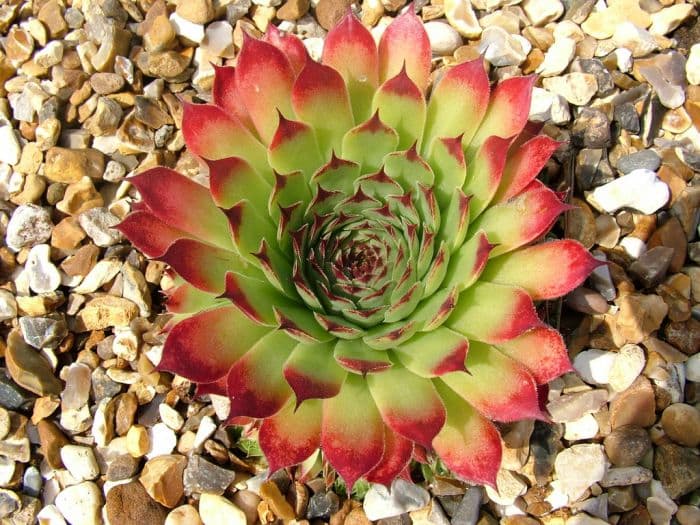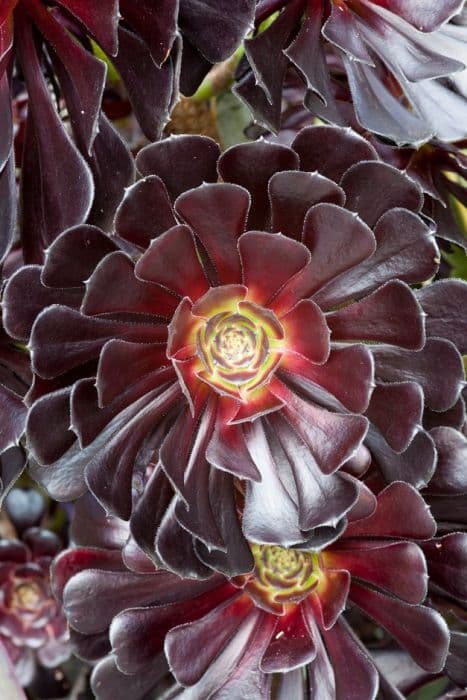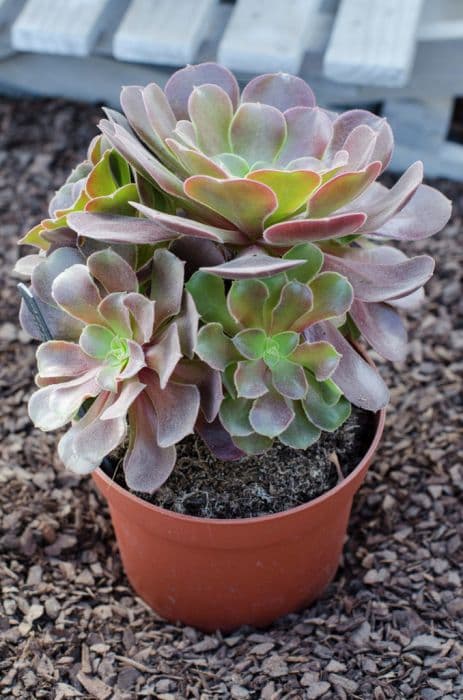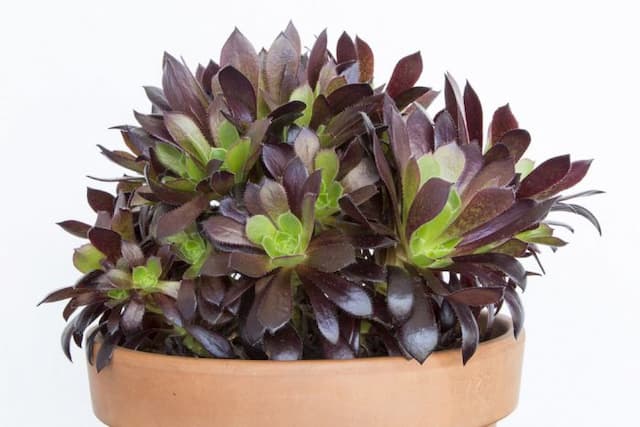Hen and Chicks Sempervivum calcareum 'Mrs Giuseppi'

ABOUT
The plant Sempervivum calcareum 'Mrs Giuseppi', commonly known as the Hens and Chicks, boasts a distinctive look that easily captures the eye. This succulent forms low clusters of fleshy leaves, which have a bold rosette shape that serves as its primary feature. Its leaves are thick and pointed, presenting a stunning array of colors that usually blend from deep green at the base to a reddish-purple at the tips. This gradient of color adds to the visual interest and makes it particularly attractive in succulent gardens or as ground cover. The leaves of Hens and Chicks are often adorned with delicate, web-like hairs that glisten in the sunlight, adding texture and character to the rosettes. The color intensity can vary depending on the amount of sunlight the plant receives, with the hues becoming more vibrant when the plant is exposed to full sun. The rosettes sit closely together, creating a mat-like appearance, and over time, they produce offsets which spread out around the mother plant, contributing to its common name as these offsets resemble a hen surrounded by her chicks. During the flowering period, Hens and Chicks can send up tall flower stalks, which contrast with the compact nature of the rosettes. The blooms can be star-shaped and are typically of a different shade than the foliage, adding another layer of interest to this already eye-catching plant. Despite its ornate and sometimes colorful appearance, the plant is known for its hardiness and ability to thrive in tough conditions where other plants might not do as well.
About this plant
 Names
NamesFamily
Crassulaceae
Synonyms
Hen And Chicks, Houseleek
Common names
Sempervivum calcareum 'Mrs Giuseppi'.
 Toxicity
ToxicityTo humans
Houseleek (Sempervivum calcareum 'Mrs Giuseppi') is not known to be toxic to humans. Ingesting any part of the plant typically does not result in poisoning. Therefore, there are no specific symptoms associated with houseleek poisoning in humans since it is commonly considered safe.
To pets
Houseleek is also not known to be toxic to pets. It is generally considered safe for cats, dogs, and other household pets. Ingesting this plant should not cause any serious symptoms of poisoning in pets. However, individual animals might have different sensitivities, and consuming plant material can sometimes lead to mild gastrointestinal upset purely from the ingestion of non-food items.
 Characteristics
CharacteristicsLife cycle
Perennials
Foliage type
Evergreen
Color of leaves
Green
Flower color
Pink
Height
6 inches (15 cm)
Spread
1 foot (30 cm)
Plant type
Succulent
Hardiness zones
5
Native area
Europe
Benefits
 General Benefits
General Benefits- Easy to care for: Sempervivum calcareum 'Mrs Giuseppi', commonly known as Hen and Chicks, is a low-maintenance plant that requires minimal watering and can thrive in a variety of conditions.
- Drought-resistant: This plant is well-suited for xeriscaping and areas susceptible to drought, due to its ability to store water in its leaves.
- Cold hardy: Hen and Chicks can withstand cold temperatures, making it a good choice for gardens in cooler climates.
- Attractive foliage: With its striking rosette shape and colorful leaves, Hen and Chicks adds visual interest to rock gardens, green roofs, and container plantings.
- Propagation: The plant readily produces offsets, allowing for easy propagation and the creation of more plants for use in the garden or to share with others.
- Pest-resistant: Hen and Chicks is not prone to many pests, which helps reduce the need for chemical treatments in the garden.
 Medical Properties
Medical PropertiesThis plant is not used for medical purposes.
 Air-purifying Qualities
Air-purifying QualitiesThis plant is not specifically known for air purifying qualities.
 Other Uses
Other Uses- Sempervivum calcareum 'Mrs Giuseppi', commonly known as Hen and Chicks, can be used as a living mulch in garden beds, reducing water evaporation and suppressing weed growth.
- These plants can serve as a creative alternative to traditional roof coverings, contributing to roof insulation and aiding in the regulation of building temperature.
- Hen and Chicks are often utilized in outdoor fairy garden creations, providing a low-maintenance and whimsical groundcover that complements miniature structures and accessories.
- The rosette shapes and textures of Hen and Chicks can be used in mixed-media art projects, where the plants are incorporated into live sculptures or natural art installations.
- They can be planted in gaps or crevices of stone walls or walkways, where they thrive and add a touch of greenery to hardscaped areas.
- In educational settings, Hen and Chicks can be used to teach children about vegetative reproduction and survival strategies in plants, as they easily propagate from offsets.
- These plants can be used as a natural way to gauge the moisture levels in an outdoor environment, as their leaves plump with adequate water and wrinkle during drought conditions.
- Hen and Chicks can be utilized in green burial practices, planted as part of a living grave marker or memorial that changes and grows over time.
- They are perfect for incorporating into miniature living wreaths or table centerpieces for rustic or nature-themed events such as weddings or garden parties.
- As a resilience symbol, Hen and Chicks can be gifted to convey a message of endurance and survival in challenging conditions, offering an alternative to traditional sympathy or encouragement gifts.
Interesting Facts
 Feng Shui
Feng ShuiThe Hen and Chicks plant is not used in Feng Shui practice.
 Zodiac Sign Compitability
Zodiac Sign CompitabilityThe Hen and Chicks plant is not used in astrology practice.
 Plant Symbolism
Plant Symbolism- Longevity: Sempervivum, also known as "Houseleek," is symbolic of long life and enduring love, as they can survive in harsh conditions and live for many years.
- Protection: Historically, Houseleeks were planted on roofs to protect against lightning and fire, representing safety and security.
- Self-reliance: Houseleeks are succulents that store water in their leaves, symbolizing adaptability and self-sufficiency.
- Perseverance: Their ability to thrive in poor soil and resist drought reflects resilience and the capability to endure hard times.
 Water
WaterThe common name for Sempervivum calcareum 'Mrs Giuseppi' is Hen and Chicks. Water this plant infrequently but thoroughly. It should be watered when the soil is completely dry. Depending on the temperature and humidity, this might be every 7 to 10 days. Provide enough water to soak the soil and reach the roots, approximately 0.25 gallons per plant, avoiding the rosettes themselves to prevent rot. During colder months, reduce watering to prevent root rot, as the plant is dormant and uses less water.
 Light
LightHen and Chicks thrives best in full sun to partial shade. Consider placing it in a south-facing window or any spot where it can get at least 6 hours of direct sunlight. If grown outdoors, choose a sunny spot, but in extremely hot climates, afternoon shade can help prevent scorching.
 Temperature
TemperatureHen and Chicks prefer a temperature range between 65°F and 75°F but can endure temperatures as low as 20°F and as high as 80°F. They are cold hardy and can survive freezing temperatures for short periods, making them suitable for many climates.
 Pruning
PruningHen and Chicks plants generally do not require pruning, however, it is beneficial to remove dead or damaged leaves as needed to maintain its appearance and health. Prune in the spring or early summer, which is the best time to tidy up the plant after winter.
 Cleaning
CleaningAs needed
 Soil
SoilHen and chicks thrive in well-draining soil with a gritty mix, like 50% perlite or coarse sand mixed with 50% potting soil. A soil pH of around 6.0 to 6.5 is ideal for this succulent.
 Repotting
RepottingHen and chicks should be repotted every 2-3 years to refresh the soil and accommodate growth, ideally during the spring or early summer.
 Humidity & Misting
Humidity & MistingHen and chicks prefer a dry climate and do well in low humidity conditions, as high humidity can promote rot.
 Suitable locations
Suitable locationsIndoor
Place Hen and chicks near a sunny window and ensure good airflow.
Outdoor
Plant Hen and chicks in full sun to partial shade areas.
Hardiness zone
3-8 USDA.
 Life cycle
Life cycleSempervivum calcareum 'Mrs. Giuseppi', commonly known as Hen and Chicks, begins its life cycle as a seed that germinates in well-drained soil and adequate light conditions. The seedling grows into a rosette, the primary form of this succulent, developing thick, fleshy leaves that store water. As it matures, the hen (main rosette) produces offsets, which are the 'chicks' that surround the mother plant and can be detached to propagate new plants. The Hen and Chicks plant is perennial, continuing to grow and produce new chicks each year. After several years, the 'hen' flowers once in its lifetime, typically in the summer, producing a flower stalk with star-shaped flowers before it dies. After flowering, the mother rosette dies back, leaving the chicks to continue the colony and eventually repeat the life cycle when they reach maturity.
 Propogation
PropogationPropogation time
Spring-Early Summer
The Sempervivum calcareum 'Mrs Giuseppi', commonly known as Hen and Chicks, is usually propagated by offsets, which are the small rosettes that form at the base of the parent plant. The best time for propagation is spring through early summer, when the plant is actively growing. To propagate, gently twist the offsets from the main rosette ensuring they have some roots attached. Then place the offsets on top of well-draining soil mix, without burying them too deep. Keep the soil slightly moist until roots establish, which should take about two to four weeks. After rooting, care for them as mature plants. This method harnesses the plant's natural reproductive strategy, making it the most popular and successful way to propagate Hen and Chicks.









